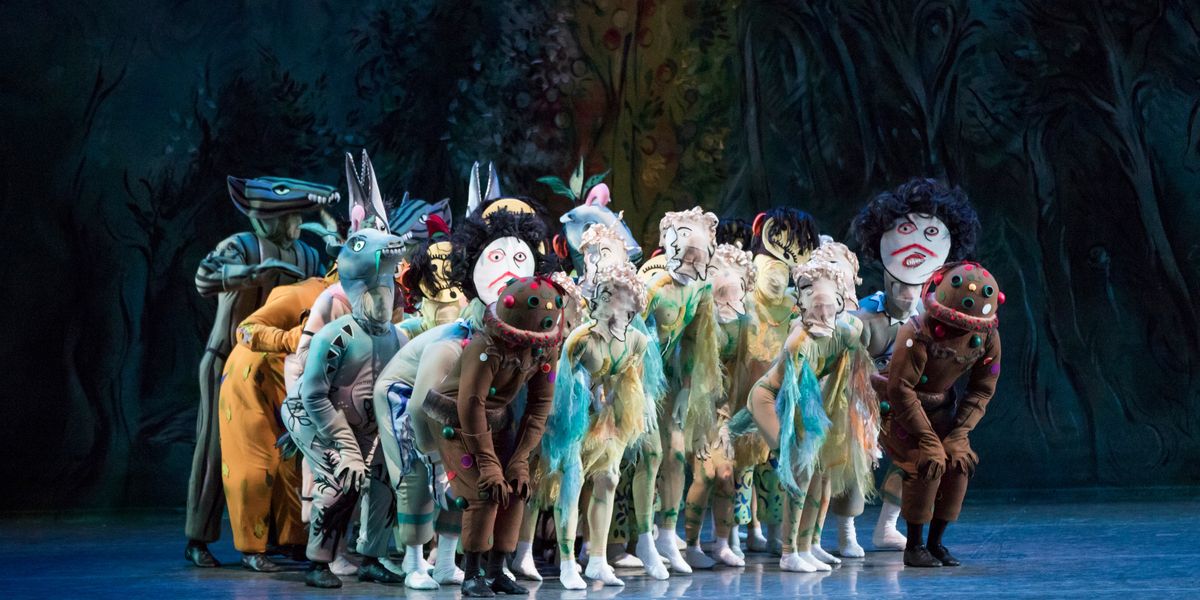Inside the Fantastical Costume World of Marc Chagall
I am a self-confessed costume nerd who really needs little persuasion to travel nearly 3,000 miles to see a costume exhibition—which is what I did when I set off for California for the new exhibition at Los Angeles County Museum of Art: Chagall: Fantasies for the Stage. I knew Marc Chagall primarily for his sumptuous blue swirling paintings featuring violin-playing goats, his incredible ceiling at the Paris Opéra’s Palais Garnier, and murals at the Metropolitan Opera House in New York City, so I was intrigued to see his work with ballet.
Marc Chagall (1887–1985), was born Moishe Zakharovich Shagal in Belarus. He later moved to St. Petersburg, Russia, to study art, apprenticing under famed Ballets Russes designer Leon Bakst. Chagall’s work in ballet and opera, however, did not begin until he and his wife Bella arrived in the U.S. as World War II refugees in 1941.
Chagall: Fantasies for the Stage
, adapted from an earlier exhibition at the Montreal Music of Art and curated by Yuval Sharon and Jason H. Thompson, is an exciting opportunity to see 41 costumes and nearly 100 designs. But it is the costumes that really steal the show. You won’t see any tutus here, but instead amazing, almost cartoon-like realizations of Chagall’s artwork. LACMA’s exhibition runs through January 7, 2018. For those of you who can’t make the trip like I did, here’s a rundown of highlights.
 The original costumes from Leonid Massine’s 1942 ballet “Aleko.” Photo by Fredrik Nilsen, Courtesy LACMA.
The original costumes from Leonid Massine’s 1942 ballet “Aleko.” Photo by Fredrik Nilsen, Courtesy LACMA.
Aleko
This first ballet was created in 1942 for Ballet Theatre (now American Ballet Theatre). Based on the poem The Gypsies by Alexander Pushkin, Aleko was choreographed by Leonide Massine, with music by Tchaikovsky. The ballet told the story of Aleko, a young man who falls in love with the gypsy girl Zymphira, yet eventually kills her. Production was moved to Mexico City as New York City union regulations wouldn’t allow Chagall to paint his own sets. In Mexico, Chagall tackled the backdrops while his wife worked on the costumes, which he finished with hand-painting. Of the four productions displayed, the costumes for Aleko are the only originals. The costume for the Fish is my favorite!
 This 1945 watercolor costume design for the yellow monster in “Firebird” is a work of art in itself. Photo © 2017 Archives Marc et Ida Chagall, Paris, Courtesy LACMA.
This 1945 watercolor costume design for the yellow monster in “Firebird” is a work of art in itself. Photo © 2017 Archives Marc et Ida Chagall, Paris, Courtesy LACMA.
Firebird
The 1945 production of Stravinsky’s Firebird was also created for Ballet Theatre. This was the first work Chagall undertook after the sudden death of his wife and marked his re-engagement with the art world. The ballet was sold to NYCB in 1949 where Balanchine recreated the choreography. It was revived in 1970 with costumes remade by the incomparable Barbara Karinska. NYCB still performs this production.
 The monster with donkey’s head from Balanchine’s “Firebird.” Photo © 2017 Museum Associates/LACMA
The monster with donkey’s head from Balanchine’s “Firebird.” Photo © 2017 Museum Associates/LACMA
The costumes for the sorcerer Koschei and a selection of his monsters are displayed – these are truly incredible, spectacular and grotesque – and must be a huge challenge to dance in!
 Teresa Reichlen and dancers of NYCB in “Firebird.” Photo by Paul Kolnik, Courtesy NYCB.
Teresa Reichlen and dancers of NYCB in “Firebird.” Photo by Paul Kolnik, Courtesy NYCB.
 Chagall’s Shepherdesses costumes for George Skibine’s “Daphnis and Chloe.” Photo © 2017 Museum Associates/LACMA
Chagall’s Shepherdesses costumes for George Skibine’s “Daphnis and Chloe.” Photo © 2017 Museum Associates/LACMA
Daphnis and Chloe
Created in 1948 for the Paris Opéra Ballet, Daphnis and Chloe, set to the music of Ravel and choreographed by George Skibine, was Chagall’s third and final ballet. The costumes are softer and lighter showing Chagall’s evolving style. He must have had fun—Pan (in foreground below) is particularly imposing!
 Pan and other costumes from “Daphnis and Chloe.” Photo by Fredrik Nilsen, Courtesy LACMA.
Pan and other costumes from “Daphnis and Chloe.” Photo by Fredrik Nilsen, Courtesy LACMA.
 Costumes from “The Magic Flute.” Photo by Fredrik Nilsen, Courtesy LACMA.
Costumes from “The Magic Flute.” Photo by Fredrik Nilsen, Courtesy LACMA.
The Magic Flute
The last work is Chagall’s only opera. These designs took Chagall three years to create. The production premiered at the Metropolitan Opera House in 1967 as part of the Lincoln Center’s inaugural season. The costumes are created collage-style with layer upon layer of fabric and no hand-painting. My favorite piece is the Lion costume – viewed from one side it appears to be giving a slightly befuddled smile, but on the other a menacing grimace!
 Photo by Fredrik Nilson, Courtesy LACMA.
Photo by Fredrik Nilson, Courtesy LACMA.
The exhibition has been designed in a very theatrical way – one enters under a swag of crimson and gold fringed curtain. The productions have been laid out chronologically with simulated backdrops behind each tableau, film footage and excerpts of the score playing. The exhibition does, however, feel somewhat disjointed—it would have been great to see production photos alongside the physical costumes, and descriptions do not state who originally wore them. (It was only after some searching that I realized I was looking at Alicia Markova’s costume from Aleko!) While elements of the exhibition could have been better designed, it is a wonderful opportunity to see these works of art and dance up close. And definitely worth my trip to the West Coast!
 One of the backdrops from “Aleko.” Digital image © 2017 The Museum of Modern Art/licensed by SCALA/Art Resource, NY. Courtesy LACMA.
One of the backdrops from “Aleko.” Digital image © 2017 The Museum of Modern Art/licensed by SCALA/Art Resource, NY. Courtesy LACMA.





